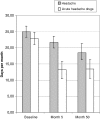A 4-year follow-up of patients with medication-overuse headache previously included in a randomized multicentre study
- PMID: 21207237
- PMCID: PMC3094644
- DOI: 10.1007/s10194-010-0285-1
A 4-year follow-up of patients with medication-overuse headache previously included in a randomized multicentre study
Abstract
The aim of this study was to evaluate the long-term outcome in 61 patients with medication-overuse headache (MOH) who 4 years previously had been included in a randomized open-label prospective multicentre study. Sixty patients still alive after 4 years were invited to a follow-up investigation. Fifty patients (83%) participated. Sixteen visited a neurologist, 22 were interviewed through telephone, 2 gave response by a letter, and 10 were evaluated through hospital records. The influence of baseline characteristics on outcome 4 years later was evaluated by non-parametric tests. p values below 0.01 were considered significant. At follow-up, the 50 persons had a mean reduction of 6.5 headache days/month (p < 0.001) and 9.5 acute headache medication days/month (p < 0.001) compared to baseline. Headache index/month was reduced from 449 to 321 (p < 0.001). Sixteen persons (32%) were considered as responders due to a ≥50% reduction in headache frequency from baseline, whereas 17 (34%) persons met the criteria for MOH. None of the baseline characteristics consistently influenced all five outcome measures. Total Hospital Anxiety and Depression Scale (HADS) score at baseline was predictors (p < 0.005) for being a responder after 4 years. At 4 years' follow-up, one-third of the 50 MOH patients had ≥50% reduction in headache frequency from baseline. A low total HADS score at baseline was associated with the most favorable outcome.
Trial registration: ClinicalTrials.gov NCT00918671.
Figures
Similar articles
-
A randomized controlled trial on medication-overuse headache: outcome after 1 and 4 years.Acta Neurol Scand Suppl. 2011;(191):38-43. doi: 10.1111/j.1600-0404.2011.01542.x. Acta Neurol Scand Suppl. 2011. PMID: 21711255 Clinical Trial.
-
Dependence scores predict prognosis of medication overuse headache: a prospective cohort from the Akershus study of chronic headache.Pain. 2012 Mar;153(3):682-686. doi: 10.1016/j.pain.2011.12.008. Epub 2012 Jan 24. Pain. 2012. PMID: 22281099
-
Disability, anxiety and depression in patients with medication-overuse headache in primary care - the BIMOH study.Eur J Neurol. 2016 Jan;23 Suppl 1:28-35. doi: 10.1111/ene.12850. Eur J Neurol. 2016. PMID: 26563095 Clinical Trial.
-
Medication overuse headache: a critical review of end points in recent follow-up studies.J Headache Pain. 2010 Oct;11(5):373-7. doi: 10.1007/s10194-010-0221-4. Epub 2010 May 16. J Headache Pain. 2010. PMID: 20473701 Free PMC article. Review.
-
Treatment of medication overuse headache-A review.Acta Neurol Scand. 2019 May;139(5):405-414. doi: 10.1111/ane.13074. Epub 2019 Mar 8. Acta Neurol Scand. 2019. PMID: 30710346 Review.
Cited by
-
Update on Medication-Overuse Headache and Its Treatment.Curr Treat Options Neurol. 2015 Aug;17(8):368. doi: 10.1007/s11940-015-0368-z. Curr Treat Options Neurol. 2015. PMID: 26139553
-
Medication overuse headache: history, features, prevention and management strategies.CNS Drugs. 2013 Nov;27(11):867-77. doi: 10.1007/s40263-013-0081-y. CNS Drugs. 2013. PMID: 23925669 Review.
-
Chronic migraine plus medication overuse headache: two entities or not?J Headache Pain. 2011 Dec;12(6):593-601. doi: 10.1007/s10194-011-0388-3. Epub 2011 Sep 22. J Headache Pain. 2011. PMID: 21938457 Free PMC article. Review.
-
Effect of selective serotonin reuptake inhibitor treatment on the prognosis of patients with medication overuse headache.Medicine (Baltimore). 2018 Mar;97(12):e0193. doi: 10.1097/MD.0000000000010193. Medicine (Baltimore). 2018. PMID: 29561441 Free PMC article.
-
Dependency-like behaviors and pain coping styles in subjects with chronic migraine and medication overuse: results from a 1-year follow-up study.BMC Neurol. 2014 Sep 19;14:181. doi: 10.1186/s12883-014-0181-4. BMC Neurol. 2014. PMID: 25234249 Free PMC article.
References
-
- Zwart JA, Dyb G, Hagen K, Svebak S, Stovner LJ, Holmen J. Analgesic overuse among subjects with headache, neck and low-back pain. Neurology. 2004;62:1540–1544. - PubMed
-
- Wang SJ, Fuh JL, Liu CY, Hsu LC, Wang PN, Liu HC. Chronic daily headache in Chinese elderly. Prevalence, risk factors, and biannual follow-up. Neurology. 2000;54:314–319. - PubMed
-
- Colás R, Muñoz P, Temprano R, Gómez C, Pascual J. Chronic daily headache with analgesic overuse: epidemiology and impact on quality of life. Neurology. 2004;62:1338–1342. - PubMed
MeSH terms
Associated data
LinkOut - more resources
Full Text Sources
Medical
Miscellaneous



